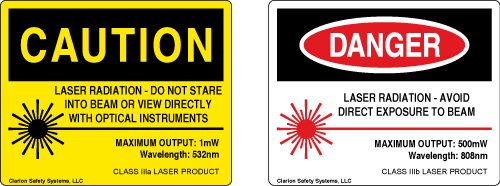CDRH and IEC Standards for Laser Labels
When it comes to laser labels, there are two main standards to follow: CDRH for U.S. markets and IEC for international markets. If you manufacture lasers and products that utilize lasers, you’ll need an understanding of how the U.S. regulations differ from the internationally-accepted standards which govern laser labeling worldwide.
CDRH-Compliant Laser Safety Labels
In the U.S., the Food and Drug Administration’s (FDA’s) Center for Devices and Radiological Health (CDRH) is in charge of laser labeling. As developed by the CDRH, the Code of Federal Regulations (CFR), Title 21, Subchapter J, Part 1040, Section 1040.10 Laser products governs the format and content of laser product safety labels. The content requirements for CDRH laser labels are based on the laser’s class, whether it is invisible/visible/invisible and visible, and whether or not the laser label appears on the product, on a non-interlocked protective housing, or on a defeatedly interlocked protective housing. The laser’s class determines if your label needs to show the maximum laser radiation output, pulse duration (when appropriate), and emitted wavelength(s). A separate label placed near the laser’s aperture may also be required.
The CDRH also requires that all products containing lasers that are imported or sold in the United States must be certified before being introduced to the marketplace. The areas reviewed in the certification process include but are not limited to:
- The product must meet the performance standards for the appropriate class. 21 CFR, 1040.10 (f). Performance features include devices such as protective housing, key switches, interlock systems, beam attenuator, labeling etc.
- User documentation (user manuals) must be generated or modified so as to reflect the informational requirements of 1040.10 (h)
- An Initial Product Report must be generated and filed with the CDRH. 1002.10 This is typically a 40 to 60-page technical document for each different model.
- A certification test procedure shall be generated and performed on each unit being certified 1010.2 (c)
- After initial certification, there are additional compliance requirements such as record keeping and filing of annual reports, 1002.13.

Even though they were revised in 2014, the CDRH regulations use a non-ISO-formatted laser symbol and circa-1941 CAUTION and DANGER safety sign formats. These formats were eliminated from ANSI Z535.4 in 2002 and, as of 2013, OSHA changed their regulations to include the newer ANSI workplace safety sign formats, signaling a movement toward the new warnings technology nationwide. Though the CDRH symbol and formats are obsolete, you have no choice but to use them if your objective is compliance with the CDRH standard.
IEC-Compliant Laser Safety Labels
The International Electrotechnical Commission (IEC) defines the content and “look” of laser safety labeling internationally in the standard IEC 60825-1 Safety of laser products – Part 1: Equipment classification, requirements, and user's guide. IEC allows for two laser label formats: a standard style and an alternate, harmonized style. The content requirements for IEC laser labels are based on the laser’s class, whether it is invisible/visible/invisible and visible, and whether or not the laser label appears on the product, on a readily overridden interlocked panel, or on a non-interlocked panel. A separate aperture label may also be required. The IEC standard allows specific radiation output information to be either placed on separate “explanatory” labels or incorporated into the laser safety label. According to IEC, the name and publication date of the standard to which the product was classified must be included on the explanatory label or on another label within close proximity.
Laser Safety Label Examples
Standard style label with a separate explanatory information panel

Standard style label with explanatory information incorporated into the label

Alternate style label with a separate explanatory information panel

Alternate style label with explanatory information incorporated into the label

Towards a Single Format for Laser Labeling
The alternate style, harmonized format is new to the laser industry and utilizes design principles in line with worldwide best practices for product safety labeling for all industries. This format choice is symbol-based (so more information can be conveyed across language barriers) and uses color-coded severity level panels to appropriately denote the level of risk. What’s more, this format is derived from the world’s principal standard for product safety labels, ISO 3864-2, and is contained in ANSI Z535.4, the nation’s principal standard for safety labels for all industries. The alternate IEC label format is part of the growing trend industries are shifting to: a greater reliance on symbols to communicate and draw attention to safety messages, precise use of severity level panels to define risk, and clear, concise text.
